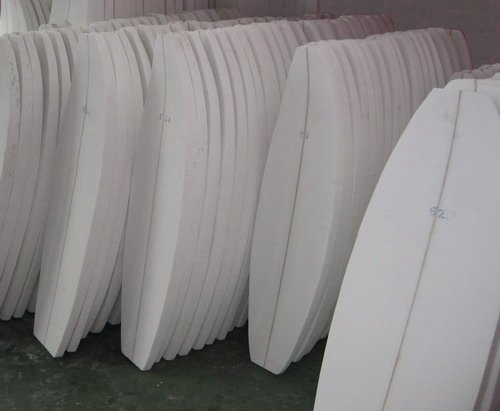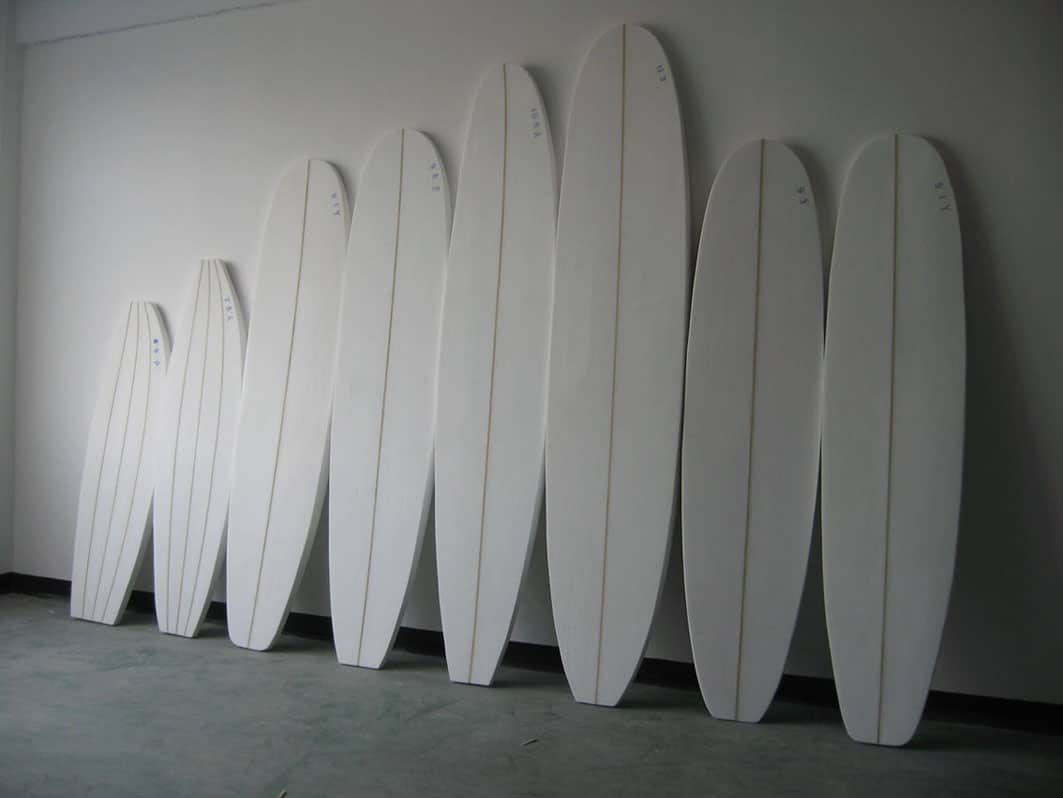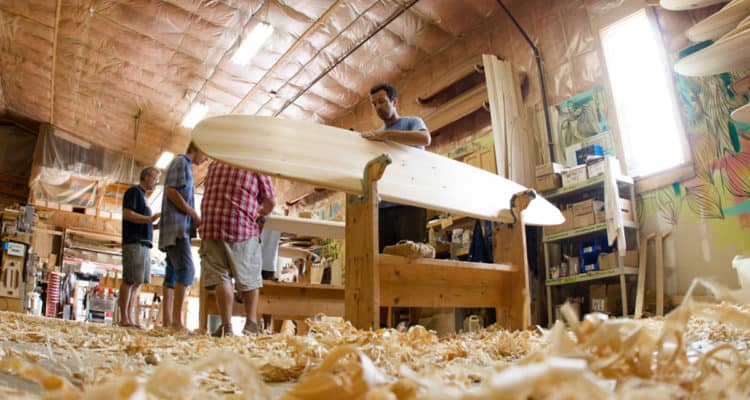Many people use surfboards and even own a few. However, not many people know what a surfboard blank is.
So, What Is A Surfboard Blank? A surfboard blank is the foam core that surfboards are made out of. It is typically made of polyurethane, polystyrene, or expanded polystyrene. A surfboard is made of foam that is shaped and covered with layers of fiberglass cloth and polyester or epoxy resin. A foam core is shaped first, and then the surfboard is glassed and painted.
Making a surfboard is a fascinating process. When crafting a board by hand a blank is used as a foundation of sorts. Much more goes into making a surfboard than just having a blank started.
The Rundown On Surfboard Blanks
A surfboard blank is the foam core that is molded into the shape of a surfboard and is ready to be shaped. At this time, the shaper finishes the surfboard entirely and puts the final touch on the board. Size and material used for the blank vary depending on which type of board is being made, and specifics wanted for the board.
Using a chosen material, typically polyurethane, a foam is molded into a blank hard foam core in the shape of a surfboard, which is split into to halves from not to tail. A wooden strip called a stringer approximately six millimeters wide is then glues between the two halves strengthening the board and reducing the risk of the board snapping.
After being formed, the blank is given to a shaper who will then cut, plan, and sand the board according to its specifications of which type of board it will be. The surfboard blank is then covered in one or several layers of fiberglass, resin, and cloth.
Foam boards are usually shaped by hand, but in recent years machines have become helpful. Machines are able to create the blanks much quicker than by hand; however, each board will then be the same. With a board being made by hand, you can have the shaper to make any specifications you would like.
In the past, balsa and hollow wooden boards were used by surfers. In many areas, these boards are becoming popular again. The production of polyurethane foam began after World War ll in the early 1950s allowing surfboard craftsmen to experiment with the new foam and fiberglass.
These early pioneers of polyurethane boards quickly saw the potential in the boards, which led to many of the boards we have today. Shapers began the art of shaping, glassing, and sanding and it has since become what many surfboards today are made of.

What Are Surfboard Blanks Made Of?
Surfboard blanks are now mostly made of polyurethane and fiberglass. Alternative materials include balsa and wood, which were used in the earlier eras of surfing and are being reintroduced in some places.
You can always find some people that enjoy making their boards out of unusual materials like glass, paper, cardboard, cork, and sometimes plastic. You will not usually find them for sale in surf shops though. These boards are making a wave, though, and a big one at that.
Eco-friendly surfboards are being made out of materials with low toxicity, renewable, up-cycled, and have a reduced carbon footprint. Some of these boards are found in online shops and are made from completely recycled materials such as plastic waste, even the fins!
We live in a time where the option of which material to have our surfboard made out seems pretty endless. Multiple options can be fun, but also a bit overwhelming. There are three main types of surfboard foam available today in surf shops and among the majority of the crowds. Each type of foam has its own unique performance characteristics.
Polyurethane
Polyurethane has long been the most traditional foam used in building surfboards. Grubby Clark first created this material in the 1950s, and it has been used widely since. Polyurethane, or PU, is exceptionally light and very easy to shape, making it a number one choice of many.
PU has a very fine and stiff composition, allowing a planer or sandpaper to run over it smoothly. The foam will come off in fine dust rather than tearing off large chunks of foam off of the blank. The shaper can then sculpt the blank with better detail. Polyurethane, however, is extremely toxic and harmful to the environment.
Polystyrene
Polystyrene, or PS, is the most common foam in use with epoxy resins but is difficult to shape. It takes much longer to work with than polyurethane. PS blanks are not as durable as PU blanks but usually have a higher density. The epoxy is used to strengthen the weakness of the polystyrene.
Surfers sometimes favor the epoxy boards because they have more durability and strength without the weight a traditional polyester fiberglass resin has. PS surfboard foams are more environmentally friendly, and the waste leftover from the blanks can be recycled.
Expanded Polystyrene
Expanded polystyrene is derived from polystyrene and had gained incredible popularity in recent years. It is actually the same material that styrofoam coolers and packing used around electronics or appliances. Expanded Polystyrene, or EPS, is made by compressing tiny foam balls together to form a sheet of foam or a blank.
EPS is extremely hard to shape by hand because of the tendency of the small balls to fall apart when sanded by sandpaper or a planer. It takes much longer to make this type of blank than other materials. On a positive note, EPS is much more environmentally friendly and is very lightweight, making it perfect for small-wave boards.
Balsa Surfboards
Balsa boards originated in Hawaii and became a favorite on the west coast in the United States in the 1940s. Balsa wood was considered the best material for surfboards because of its durable and lightweight features. Balsa boards boast features such as being lighter, more buoyant, and much easier to handle in the water than other boards.
Hollow Wooden Surfboards
Hollow wooden boards are made of wood and epoxy oil and have no foam in their construction at all. With the boards being empty, they lighter than a solid wood board. Hollow wooden boards, just as balsa boards, are the most environmentally friendly surfboards made today.
Surfers prefer wooden boards because they have no flex and are stable and stiff construction with no bend. This gives surfers more positive turns and more drive through mushy waves. Most surfers love that their wooden boards are healthier all around for the oceans they love.

Shaping Of The Surfboard By Hand
A board shaped by hand is unique, and there is a particular appreciation that comes with a board being made by hand. After being molded and a stringer glued between the two halves, the board is shaped using separate tools.
A saw is first used to cut the outline of the shape the board is meant to have. Electric planes are then used to remove the hardened outer skin of the blank and any larger areas that need to be taken off. If a rocker is to be added, it can then be combined with a power plane.
Using a rasping tool and sandpaper, fine-tuning the blank is gives the surfboard its finished shape. The surfboard is now ready to move on to its next phase of creation.
Lamination Of The Surfboard
The laminating process begins with the surfboard being covered with woven fiberglass cloth. Typically shortboards will have one layer of cloth on the bottom with two layers on the deck. Longboards generally have more layers overall than shortboards, which also adds to their buoyancy.
The fiberglass cloth can then be saturated with isophthalic resin or polyester. Fins can be attached after the resin has set, and a coat of sanding resin applied. When the sanding resin has hardened, it is sanded down until the final shape is achieved. A final coating of the resin can be applied and polished to have the effect of a gloss coat.

